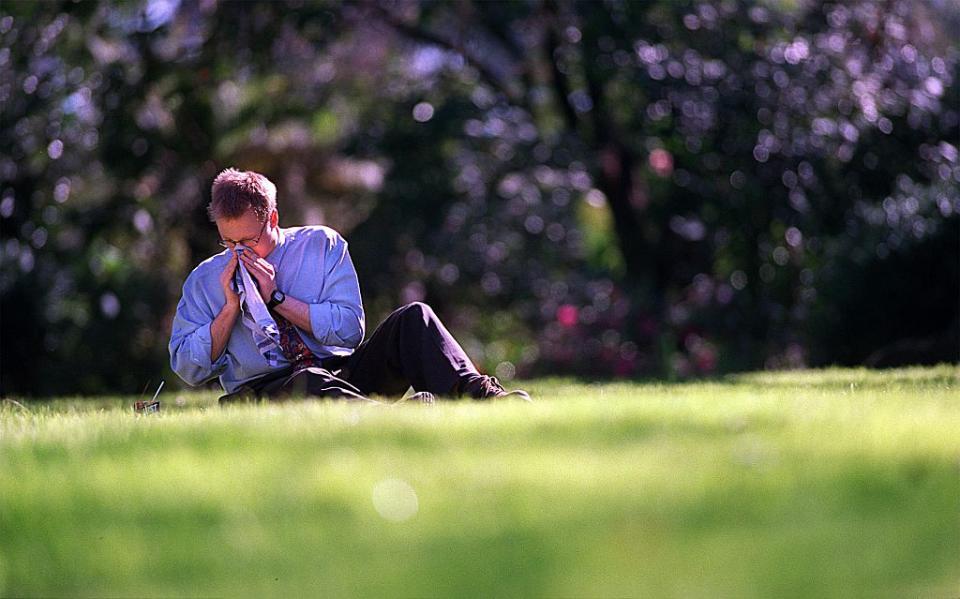How the weather affects hay fever – will it be worse this season?
It’s the time of year every hay fever sufferer dreads. But how much does spring, and the change in weather it brings, affect those who suffer from the allergy?
Nearly one in five Australians - more than 4.6 million people - are affected by hay fever, according to the latest National Health Survey.
If you’re one of the unlucky ones, you will likely endure symptoms including frequent sneezing fits, a runny or blocked nose, itchy or watery eyes and a scratchy throat.
Hay fever (or allergic rhinitis) and its annoying symptoms are caused by an allergic reaction to pollens - the male reproductive parts of plants - from grasses and trees. Other triggers for the same symptoms include house dust, animal fur, fungal spores and air pollutants.
Depending on the person, it can occur seasonally or all throughout the year but for most people the weather certainly has an impact and experience the worst of it during the spring and summer months during flowering seasons in October, November and December.

Does the weather affect hay fever?
Because many types of plant pollen rely on the wind to transport them, the wind is the natural enemy of the hay fever sufferer as big gusts can whip pollen and pollutants into the air.
In Australia pollen numbers are lower on the east coast where most winds come from the sea, and where there is protection from westerly winds by the Great Dividing Range. Pollen numbers are higher on the Victorian south coast because most winds are from the north carrying pollen from the northerly grasslands, according to the Australasian Society of Clinical Immunology and Allergy.
Humidity can also trigger people with allergies as moisture makes mould grow both in the home and outdoors, and dust mites also thrive in humid air.
Does rain help reduce hay fever?
If you’re looking for a reprieve from your runny nose and itchy eyes, you might hope for rain. But just not too much.
Damp conditions brought about by rain do stop pollen from spreading through the air and therefore limiting symptoms, but that is really only the case with light to moderate rain.
Heavy rain seems to have an adverse effect, as it can whip more pollen into the air, especially if it comes with windy conditions. It’s for this reason that authorities warn about thunderstorm asthma.
A study done by US researchers analysed 14 years of meteorological and pollen data and found that levels of pollen declined after less than 10cm of rain, but rose if there was more than 10cm.
Is hay fever worse during the day?
This one really depends on the type of pollen that is triggering your hay fever. There are many plants that release pollen in the early morning, which often makes the mid morning a difficult time to be outdoors for those with hay fever. But other species can release pollen later in the day.
As temperatures rise during the day, pollen-bearing air rises, which will then drift down later in the day as temperatures drop. The more likely that a particular type of pollen is to travel far on the wind (like the lighter Ragweed, for example), the more likely it is to be airborne later in the day.
So this really depends on where you live and the type of pollens that causes you trouble.

Where is hay fever the worst in Australia?
As mentioned, the east coast offers some of the better wind protection for hay fever sufferers.
Given that pollen is a major trigger, it mightn’t surprise you to learn that Canberra - influenced by the garden city movement - has the highest rate of hay fever.
According to the Australian Institute of Health and Welfare, the ACT had the highest rate of hay fever in 2017–18 at 29 per cent, compared to the national average of about 19 per cent.
Can you develop hay fever later in life?
The short answer is yes. While most being are born with the affliction and some might grow out of the worst of their hay fever symptoms later in life, it is possible to develop allergies in adulthood.
The likelihood of developing allergies is written into our genes and can be triggered by something like a bad flu or pneumonia that increases our sensitivity to later developing an allergy.
How to manage hay fever symptoms
There are a number of options to deal with hay fever including over-the-counter antihistamine tablets, syrups, and eye drops as well as nasal sprays, decongestant tablets and combination remedies.
For severe sufferers, you can speak to your doctor about allergen immunotherapy (AIT) which is also known as desensitisation and involves getting injections (or other methods of ingestion) with gradually increasing amounts of environmental allergen extracts to slowly build up tolerance.
Do you have a story tip? Email: newsroomau@yahoonews.com.
You can also follow us on Facebook and Twitter, download the Yahoo News app from the App Store or Google Play and stay up to date with the latest news with Yahoo’s daily newsletter. Sign up here.


